[November 2024] Apple CarPlay vs. Android Auto
Apple CarPlay and Android Auto is such a game-changer in In-Car Entertainment (ICE) technology. Both systems can improve your driving experience with intuitive interfaces, powerful voice assistants, and extensive app support.
In this blog, we will talk about the difference of the two system and give some inspiration when choosing.
Quick View of Android Auto and Apple CarPlay
| Feature | Android Auto | Apple CarPlay |
|---|---|---|
| User Interface | Multi-app view with recent shortcuts | Dashboard UI with consolidated apps |
| Navigation | Google Maps and Waze, intuitive map panning | Apple Maps. Less intuitive map interaction |
| Voice Assistant | Google Assistant, real-time transcription | Siri, limited third-party support |
| Calls and Notifications | Less intrusive, customizable notifications | More intrusive, full-screen call notifications |
| Third-party Apps | Broader app compatibility | Growing app integration |
| Wireless Support | Less reliable, potential battery drain | More reliable, fewer connectivity issues |
| Compatibility | Broad Android phone support | Broad iPhone support |
| Screenshots | Complicated process | Simple button press |
| Overall Usability | Better navigation, customizable notifications | Better wireless performance, simple UI |
Difference Between Android Auto and Apple CarPlay
Among in-car infotainment systems, Android Auto and Apple CarPlay have reformed the driving experience. The quick integration of smartphones with vehicle dashboards provides access to navigation, music, and communication apps directly.
Despite having similar goals, both systems differ slightly in terms of user interface, functionality, and experience.
User Interface

| Android Auto | Apple CarPlay | |
|---|---|---|
| Customization | Allows users to customize the app layout. You can select which apps appear on the screen. Use split-screen functionality to view two or three apps simultaneously. | Features a well-organized interface. It isn’t customizable but displays navigation, music, and Siri suggestions on a single screen. You don’t need a split-screen design. |
| Display Modes | Supports both dark and light modes. | |
| Scroll Format | Vertical scroll-down format for app icons. | Horizontal scroll-across format for icons. |
| Interface | Presents a simplified and intuitive version of the phone’s interface. It’s easy for drivers to interact with their phones while driving. | Simple and clear layout with large icons and comfortable text. Designed to minimize distractions and provide a safer way for drivers to interact with phones. |
Both of them offer an easy-to-use and simple interface. The home screen shows essential information like maps, recent songs, and reminders. Apple CarPlay scores slightly higher in visual appeal due to its bright use of colors and slick text.
Apps And Navigation

| Android Auto | Apple CarPlay | |
|---|---|---|
| Navigation | Uses Google Maps by default. It is preferred for its accuracy and real-time information. | Uses Apple Maps by default. It has significantly improved but is less user-friendly for route adjustments. |
| Route Adjustment | Easier to view and adjust routes with zoom and scroll features. | Requires tapping arrow buttons to move the map view and go back to route options to change routes. |
| Mapping Details | No detailed markings for structures | Apple Maps now offers more detailed mapping of buildings, landmarks, and lane markings. |
| Third-Party Apps | Greater support for third-party apps. The only Apple app you can use is Apple Music. | Supports several Google apps (Google Maps, Google Podcasts, Google Music, Google Calendar). There is a wide selection of third-party apps as well. |
Android Auto is a bit better due to its ease of route adjustment and support for third-party apps. Apple CarPlay also provides a selection of apps and improved mapping details. But its navigation interface is less intuitive.
Voice Assistant
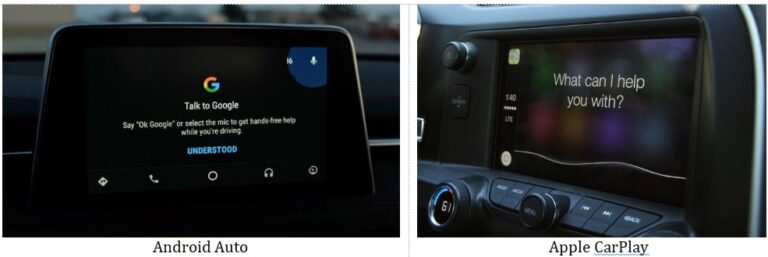
| Android Auto | Apple CarPlay | |
|---|---|---|
| Voice Assistant | Uses Google Assistant, which integrates Google AI for text summarization and relevant reply suggestions. | Uses Siri. |
| Voice Commands | Supports common tasks, hands-free calling, and texting. | |
| Third-Party Integration | Easy integration with third-party apps. | |
| Features | Superior at understanding voice commands due to NLP. Recent updates include contextually suggested responses to messages. You can message or call your favorite contacts with a single tap. The interface shows message previews for easy error detection. | CarPlay’s interface lets you change or send messages but doesn't display the message. Siri integration allows for safe and hands-free operation for various tasks, improving driver safety. |
Both Android Auto and Apple CarPlay provide hands-free capabilities through their respective voice assistants. But Google Assistant outperforms Siri in natural language processing, third-party app integration, and recent feature updates. Hence, making it the more powerful option for in-car voice interactions.
Wireless Connectivity and Screenshot Capability
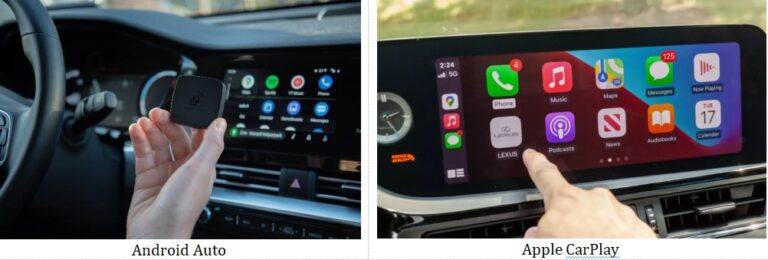
| Android Auto | Apple CarPlay | |
|---|---|---|
| Wireless Connectivity | Wireless support for Android Auto varies by manufacturer and model. Some Android devices experience issues like overheating and higher battery drain when connected wirelessly. You can mitigate the issues with aftermarket dongles. | Apple CarPlay tends to have more reliable wireless connectivity with fewer issues. It is more consistent in maintaining a stable connection over long drives. |
| Screenshot Capability | Taking a screenshot with Android Auto is a more complicated process. You need to follow multiple steps and external tools. | CarPlay allows users to take screenshots easily. You just need to press the volume up and side buttons simultaneously. |
Calls and Notifications

| Android Auto | Apple CarPlay | |
|---|---|---|
| Calls and Notifications | Notifications in Android Auto appear as banners at the top of the screen. Users can easily mute or dismiss them as needed. The non-intrusive approach helps drivers stay focused on the road. | Apple CarPlay displays notifications at the bottom of the screen. It can obscure important information like navigation directions. Also, CarPlay cannot mute or dismiss notifications selectively. |
Which One is Best for You?
Choosing between Apple CarPlay and Android Auto depends largely on your smartphone preference and specific needs.
Apple CarPlay
Integration: It integrates with iPhones easily and offers a simple and clear interface that mirrors iOS.
Features: You can enjoy hands-free texting, music streaming, and navigation using Apple Maps. It supports remote start and integrates with native apps like Calendar and third-party apps like Spotify and Audible.
User Experience: The system offers a clean and consistent experience but with limited third-party app compatibility.
Android Auto
Compatibility: It works with most Android phones and offers a familiar interface for Android users.
Features: Provides hands-free calling, texting, and navigation using Google Maps. Supports a range of third-party apps and better notification handling.
Voice Assistant: Google Assistant is generally considered more powerful and accurate than Siri. So, it offers better natural language processing and wider integration.
If you are deeply integrated into the Apple ecosystem and prefer a consistent user experience, Apple CarPlay is likely the better choice. Conversely, if you value customization, wider app support, and a more capable voice assistant, Android Auto will be more suitable.
FAQs
Conclusion
Android Auto and Apple CarPlay provide significant benefits to car-sharing drivers. The most significant benefit of becoming acquainted with these apps is that they remember all of your preferences and personalizations. Regardless of the car you choose, both can improve your driving experience.





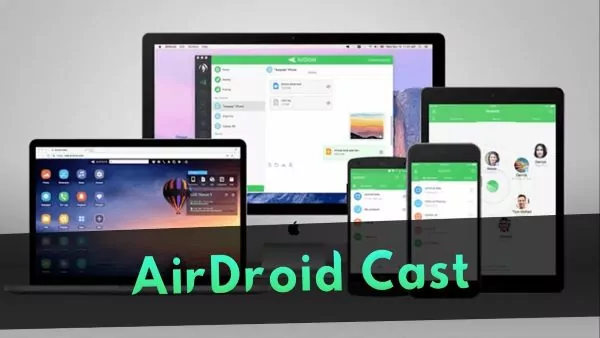
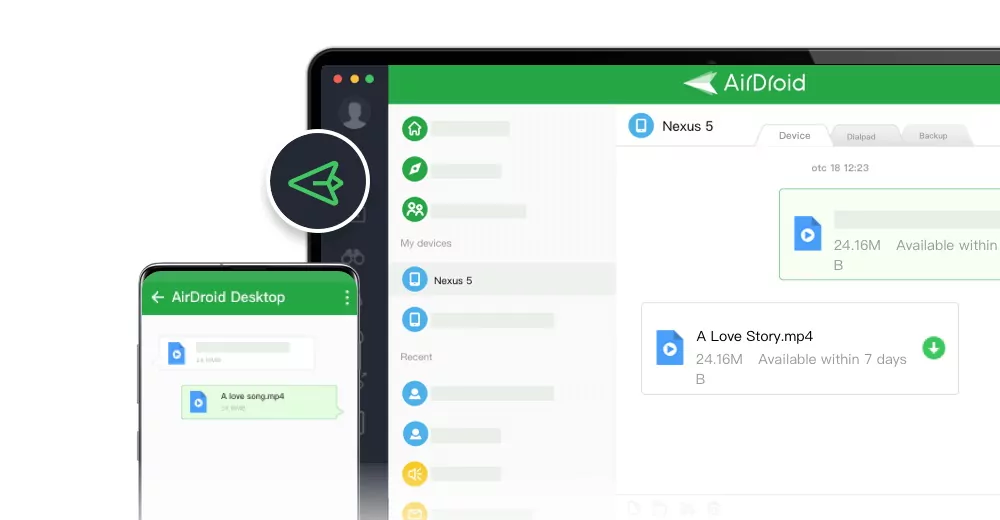



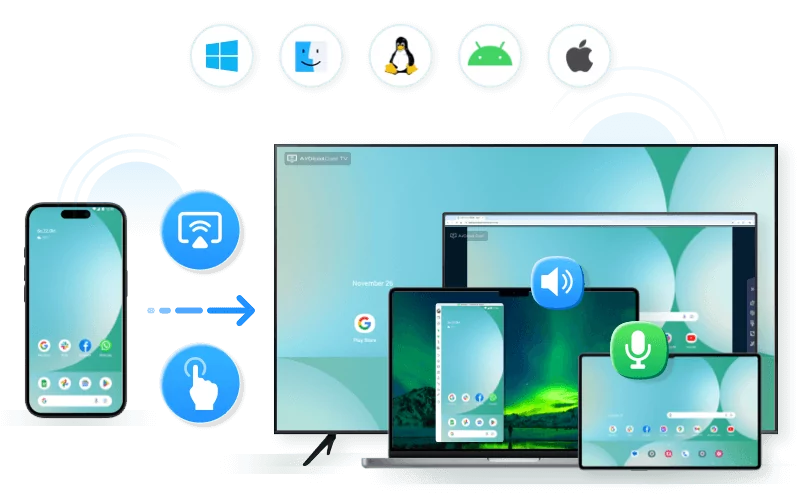
Leave a Reply.